Running a healthcare facility—whether a small clinic or a large hospital—comes with its share of…

Hospital Dashboard – Multifaceted App for Hospital Management
Reading Time: 7 minutes
Welcome to Multipurpose Themes, your ultimate destination for premium and highly customizable website templates! We specialize in providing sleek, modern, and professional templates that suit a variety of industries. Whether you’re building a corporate site, a personal blog, or a medical platform, we’ve got you covered. In this guide, we explore the key features of an advanced Hospital Dashboard for seamless management.
We are excited to present our 3 Medical Dashboard Template, designed specifically to enhance the functionality and aesthetics of healthcare websites. Our Hospital Dashboard offer advanced features that make managing patient data, doctor details, and hospital reports simple and efficient, while ensuring a seamless user experience.
BUY NOW
Medicare Admin
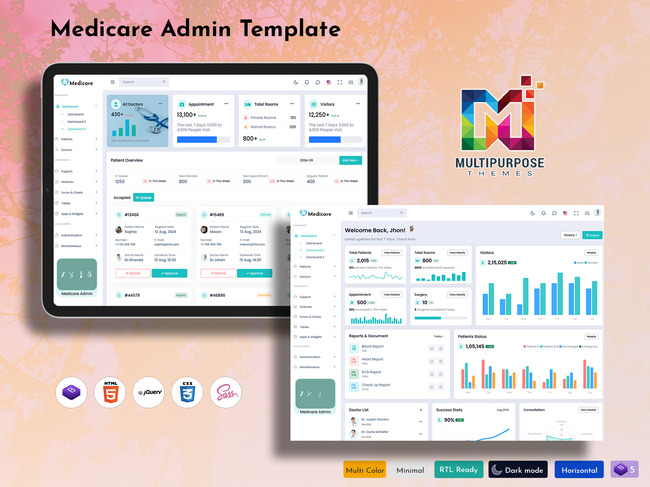
Dashboards of Medicare Admin
LTR Style – Dashboard – 1
MORE INFO / BUY NOW DEMO
New LTR Style – Dashboard – 2
MORE INFO / BUY NOW DEMO
New LTR Style – Dashboard – 3
MORE INFO / BUY NOW DEMO
Videos of Medicare Admin
1. What is a Hospital Dashboard?
A Medical Dashboard is a dynamic, digital interface that Integrates various types of healthcare-related data in an easily accessible and visually appealing format. It serves as a centralized hub for hospital administrators, doctors, and staff to track patient reports, manage doctor schedules, monitor medical equipment, and oversee operational performance. Dashboards present data through graphical representations such as charts, graphs, tables, and alerts, allowing for a quick overview of the hospital’s performance and patient health metrics.
A Medical dashboard integrates data from multiple departments (e.g., patient management, billing, pharmacy, laboratory, and radiology) to provide an all-in-one solution for hospital administration and clinical operations.
BUY NOW
Doclinic Admin
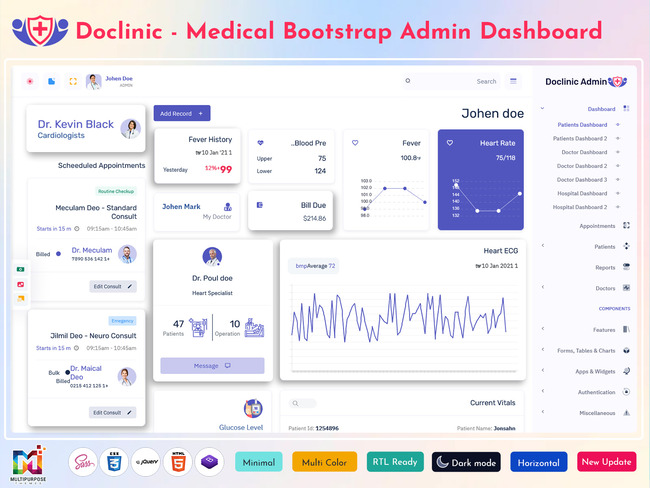
Dashboards of Doclinic Admin
LTR Style – Patients Dashboard – 1
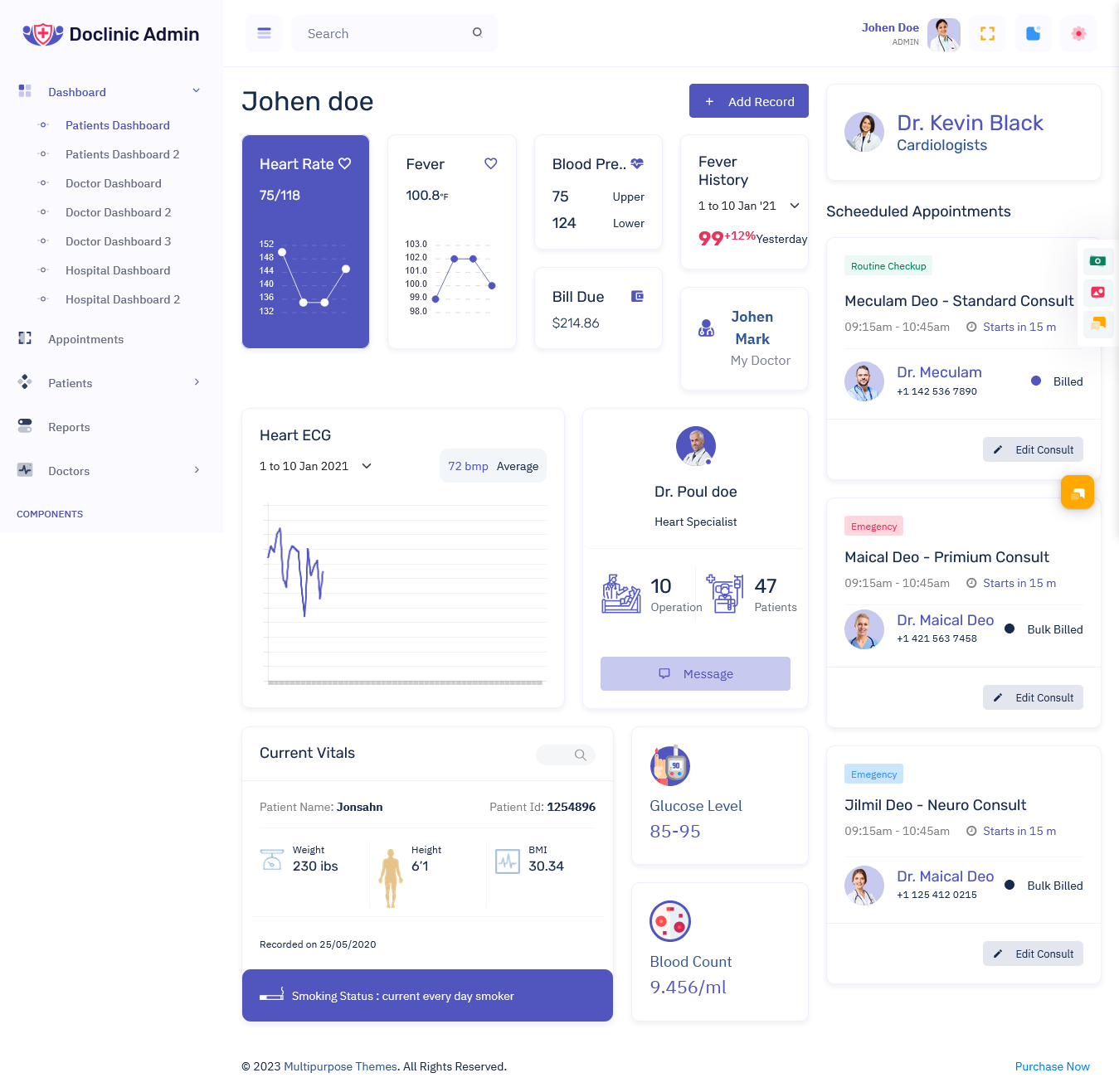
MORE INFO / BUY NOW DEMO
LTR Style – Patients Dashboard – 2
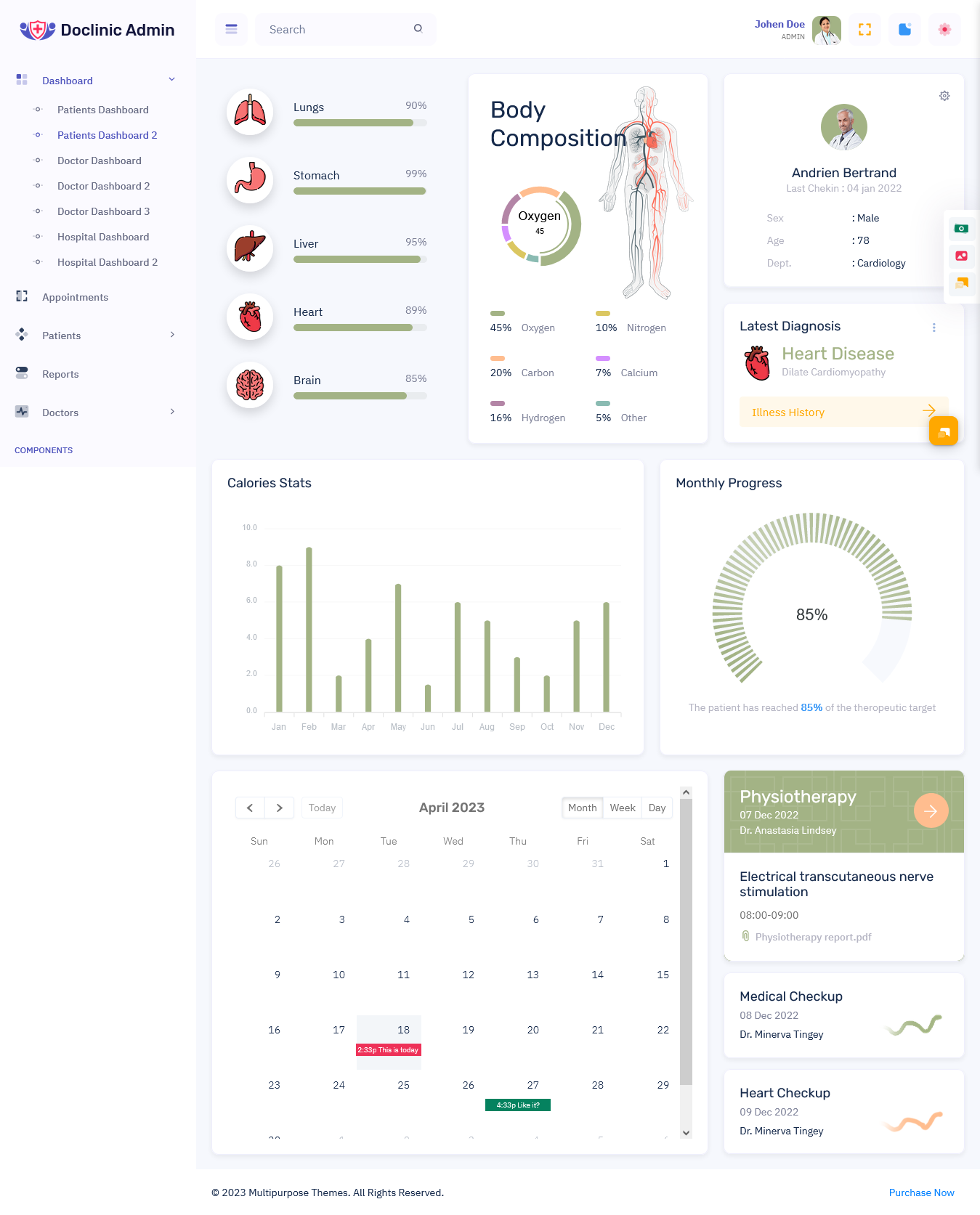
MORE INFO / BUY NOW DEMO
LTR Style – Doctor Dashboard – 1

MORE INFO / BUY NOW DEMO
LTR Style – Doctor Dashboard – 2
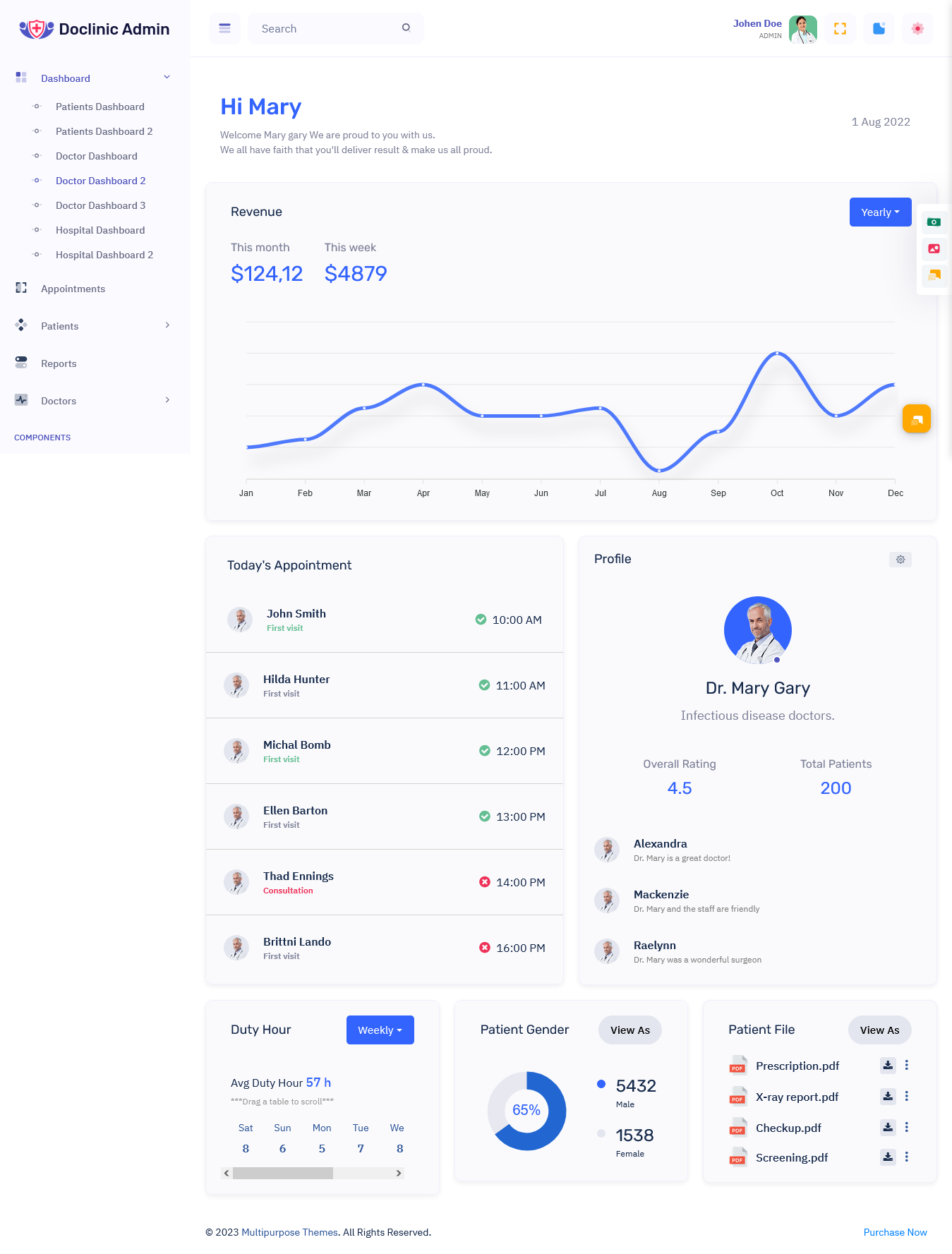
MORE INFO / BUY NOW DEMO
LTR Style – Doctor Dashboard – 3
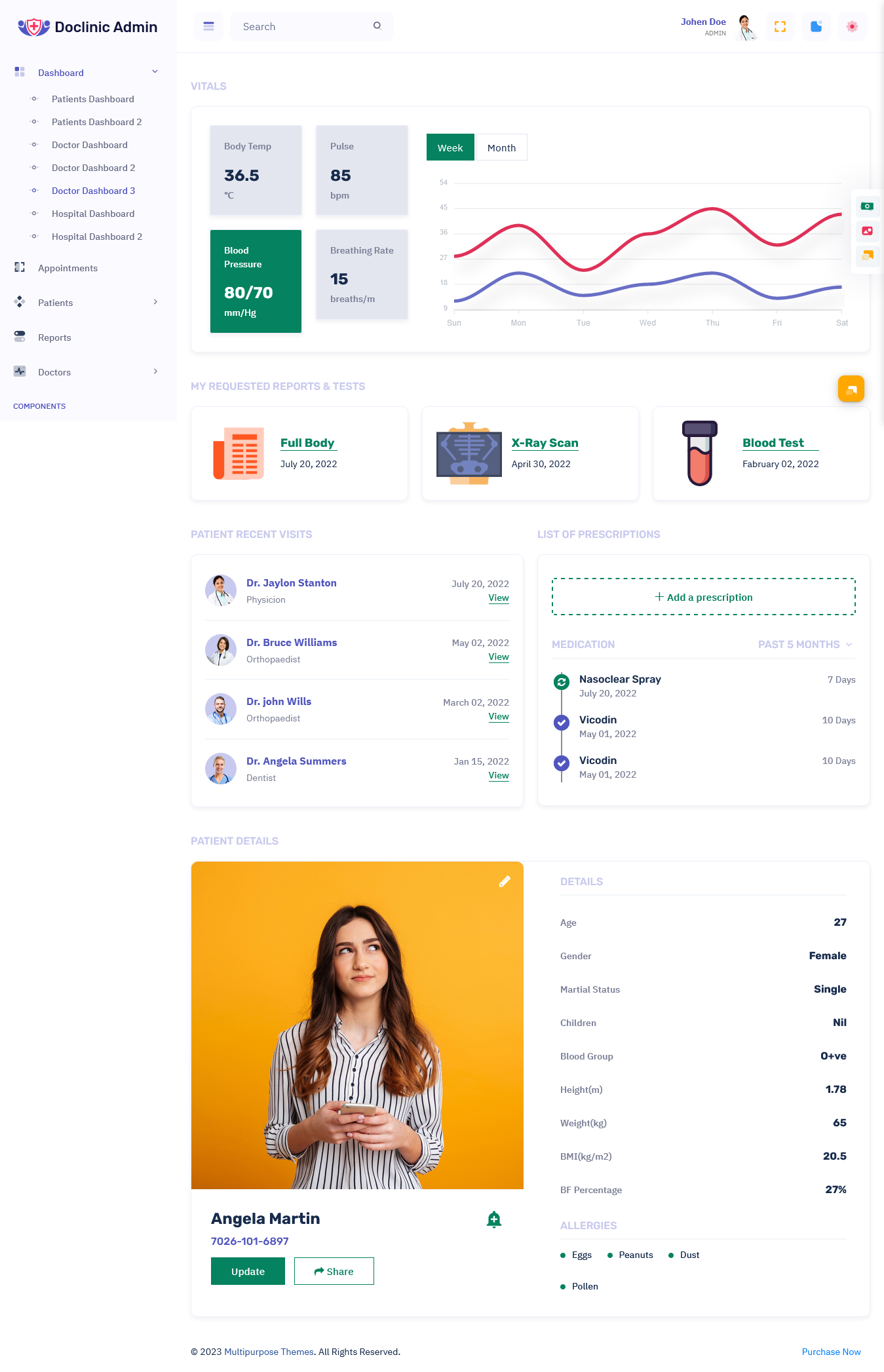
MORE INFO / BUY NOW DEMO
LTR Style – Hospital Dashboard – 1
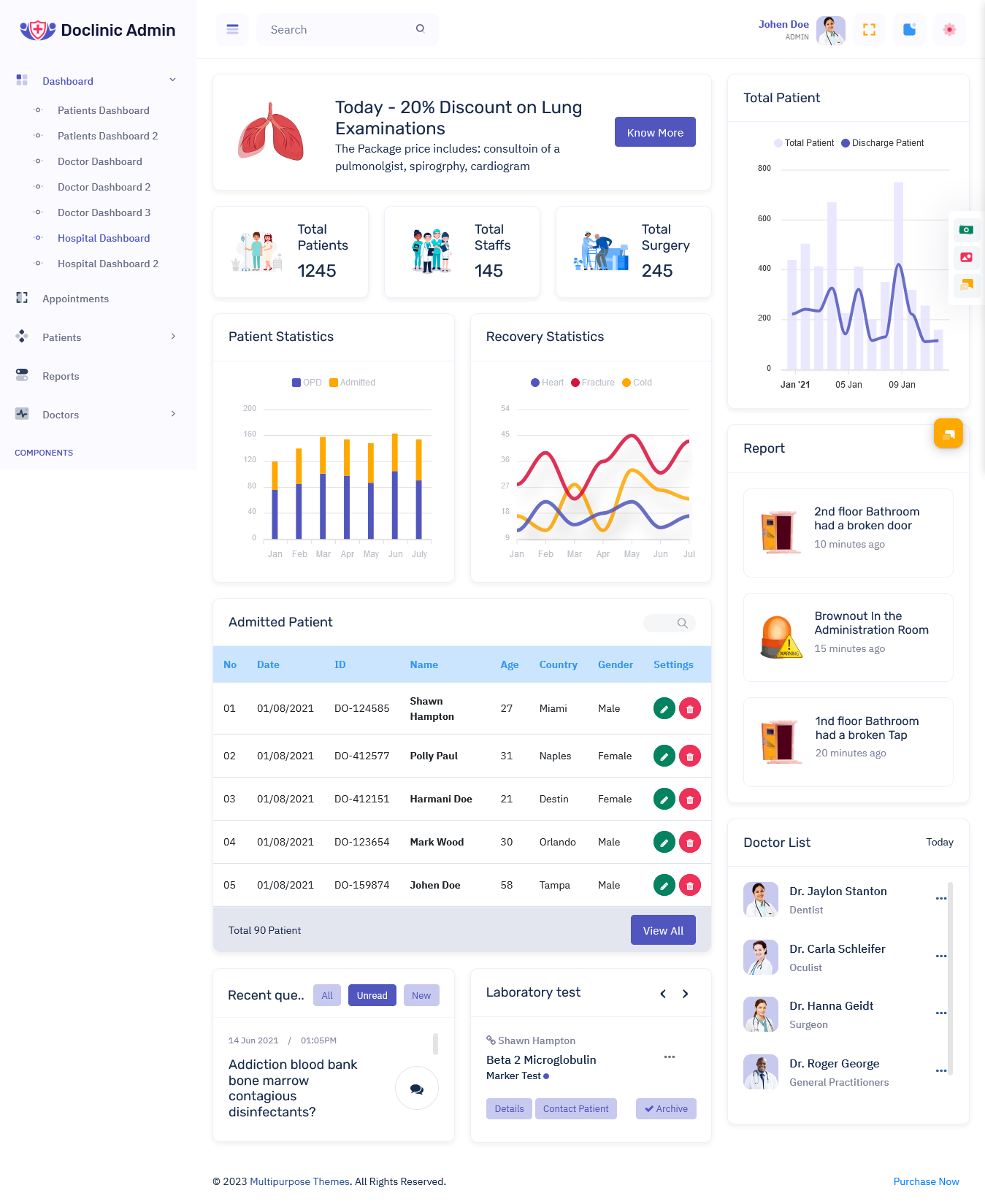
MORE INFO / BUY NOW DEMO
LTR Style – Hospital Dashboard – 2
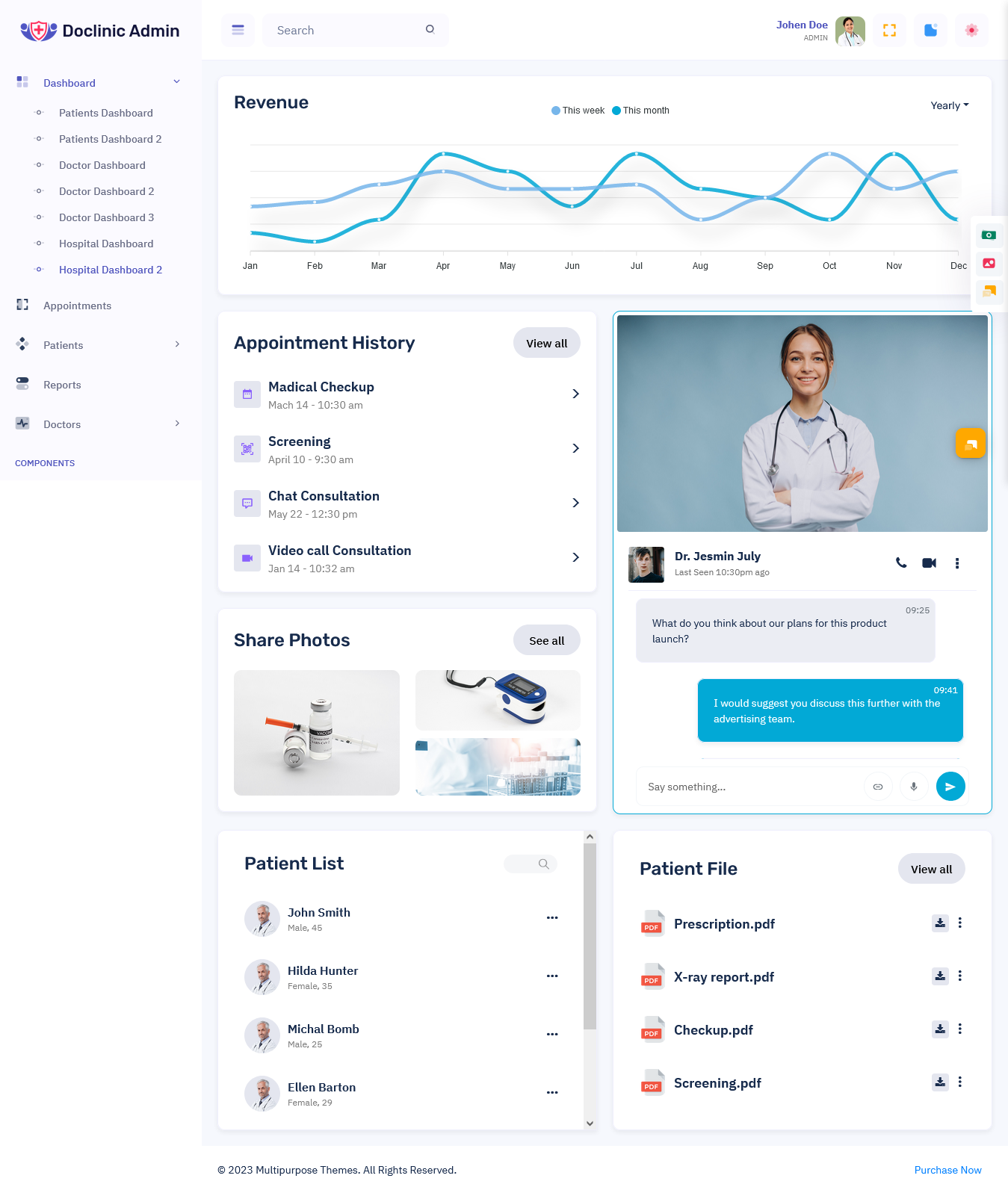
MORE INFO / BUY NOW DEMO
Videos of Doclinic Admin
2. Key Features of an Advanced Hospital Dashboard
Modern Medical Dashboard come equipped with a wide range of features that enhance operational efficiency and patient care. These features are designed to serve different stakeholders, such as medical staff, patients, and hospital administrators. Some of the key features include:
a) Patient Reports Tracking
Tracking patient health data and medical history is critical for delivering high-quality care. A well-designed hospital dashboard provides access to detailed and comprehensive patient reports, including:
Medical History: This feature enables healthcare providers to review patient history, including past diagnoses, treatments, surgeries, and any allergies. Having this data available instantly helps doctors make informed decisions.
Real-time Lab Results: Lab results, including blood tests, radiological images, and diagnostic reports, are automatically integrated into the dashboard. This ensures that the medical team can access up-to-date information without the need to navigate different departments.
Vitals Monitoring: Patient vitals such as heart rate, blood pressure, oxygen levels, and temperature can be monitored in real time. This ensures timely intervention if any abnormalities are detected.
Medication Tracking: The dashboard enables physicians and nurses to monitor patients’ medication schedules and track prescriptions. This feature helps reduce medication errors and ensures patient safety.
b) Doctor and Staff Management
An advanced hospital dashboard also assists in managing the hospital’s workforce, especially the doctors and medical staff. This includes:
Doctor Scheduling: The Medical Dashboard can show the availability of doctors across departments, helping hospital administrators schedule appointments and rotations with ease. Automated reminders for doctors can also be set up to reduce no-shows or appointment delays.
Staffing Analysis: The Hospital Dashboard can provide data on staff utilization, enabling administrators to assess whether the hospital is adequately staffed or if additional resources are needed.
Performance Analytics: Doctors and other medical staff can have performance metrics tracked through the dashboard. These can include patient feedback, treatment outcomes, and overall productivity. This data can be used for professional development and evaluations.
c) Financial Management and Billing
A hospital dashboard is also an essential tool for tracking the financial health of the hospital. It integrates financial data from various departments to offer:
Billing and Revenue Tracking: Hospital expenses, revenue, and billing details are centralized in the dashboard. Patients’ billing information, insurance details, and payment statuses can be tracked in real time, streamlining the revenue cycle.
Cost Analysis: Hospital administrators can easily monitor the cost of medical supplies, medications, and equipment, allowing for more effective budgeting and expense management.
Insurance Claim Tracking: Hospitals often need to deal with multiple insurance providers. A dashboard can provide real-time updates on the status of insurance claims and reimbursements, improving the overall cash flow of the hospital.
d) Hospital Operations and Asset Management
Efficient hospital management also involves overseeing hospital assets such as medical equipment, facilities, and supplies. A Medical Dashboard includes:
Inventory Management: From medications to medical devices, the dashboard tracks stock levels and usage. This feature ensures that hospitals can maintain adequate supply levels and prevent shortages or overstocking.
Equipment Status Monitoring: The dashboard allows administrators to track the status of key hospital equipment, such as ventilators, MRI machines, and X-ray machines. It provides alerts when equipment needs maintenance or repair, ensuring that all equipment is operational and safe to use.
Facility Management: The Hospital Dashboard can also monitor aspects of hospital facilities such as room occupancy, sanitation schedules, and maintenance issues, ensuring that the hospital runs smoothly and that patients are provided with a safe and clean environment.
e) Real-time Data Analytics and Reporting
Real-time data analytics is a crucial part of any advanced Hospital Dashboard. The ability to process large amounts of data in real time allows hospital administrators and healthcare professionals to make informed decisions quickly. With data visualization tools such as heatmaps, pie charts, and bar graphs, users can:
Monitor Patient Trends: The dashboard can show trends in patient volume, types of diseases being treated, or the effectiveness of different treatments.
Track Performance Metrics: Hospitals can track key performance indicators (KPIs) such as patient wait times, treatment success rates, and patient satisfaction scores.
Predictive Analytics: Some dashboards even incorporate AI-driven analytics to predict patient outcomes or identify potential outbreaks or spikes in specific diseases.
BUY NOW
Rhythm Admin
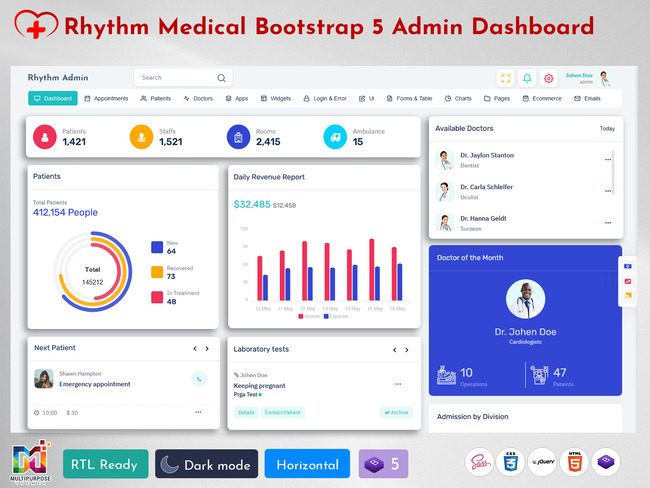
Dashboards of Rhythm Admin
LTR Style Dashboard – 1
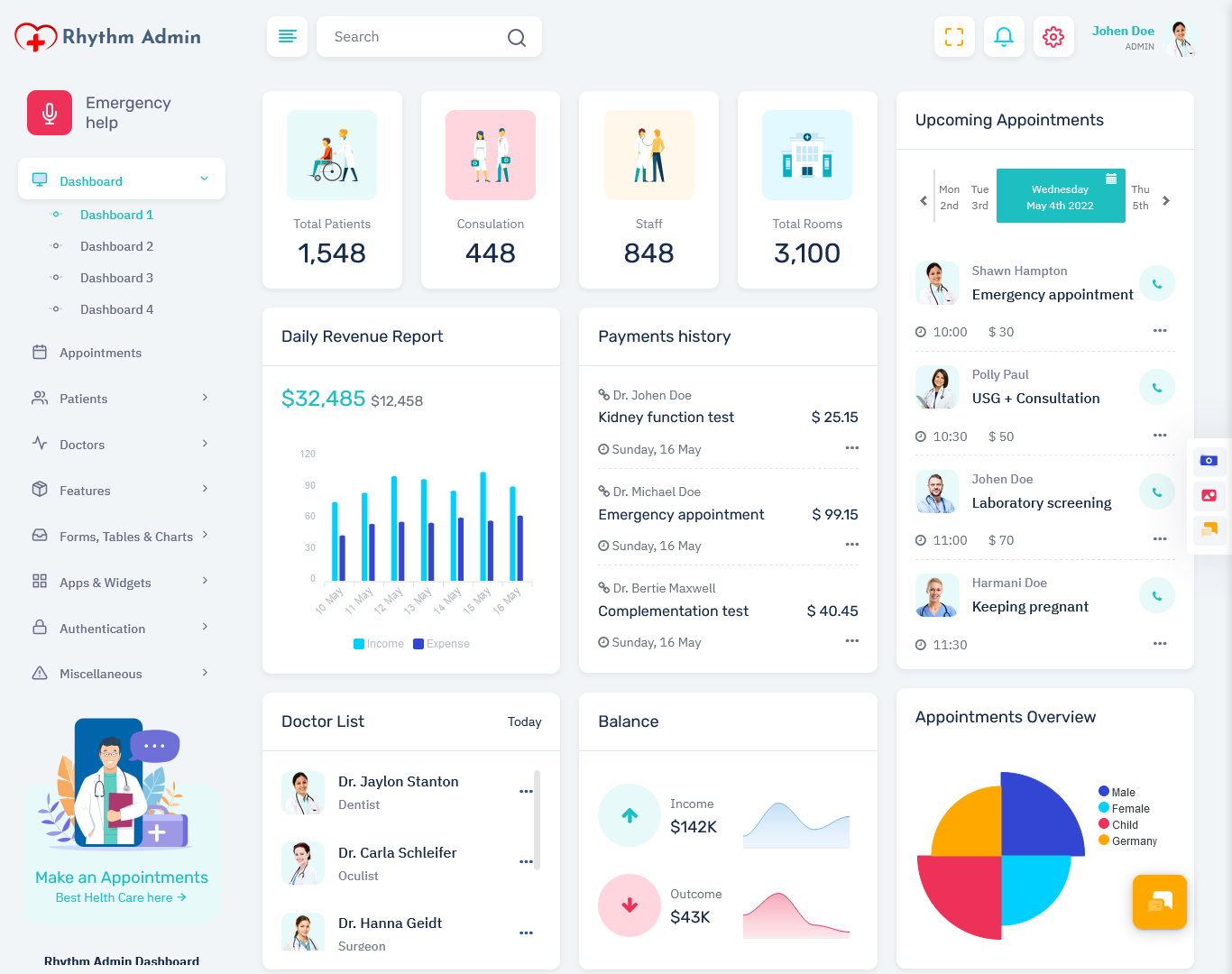
MORE INFO / BUY NOW DEMO
LTR Style Dashboard – 2
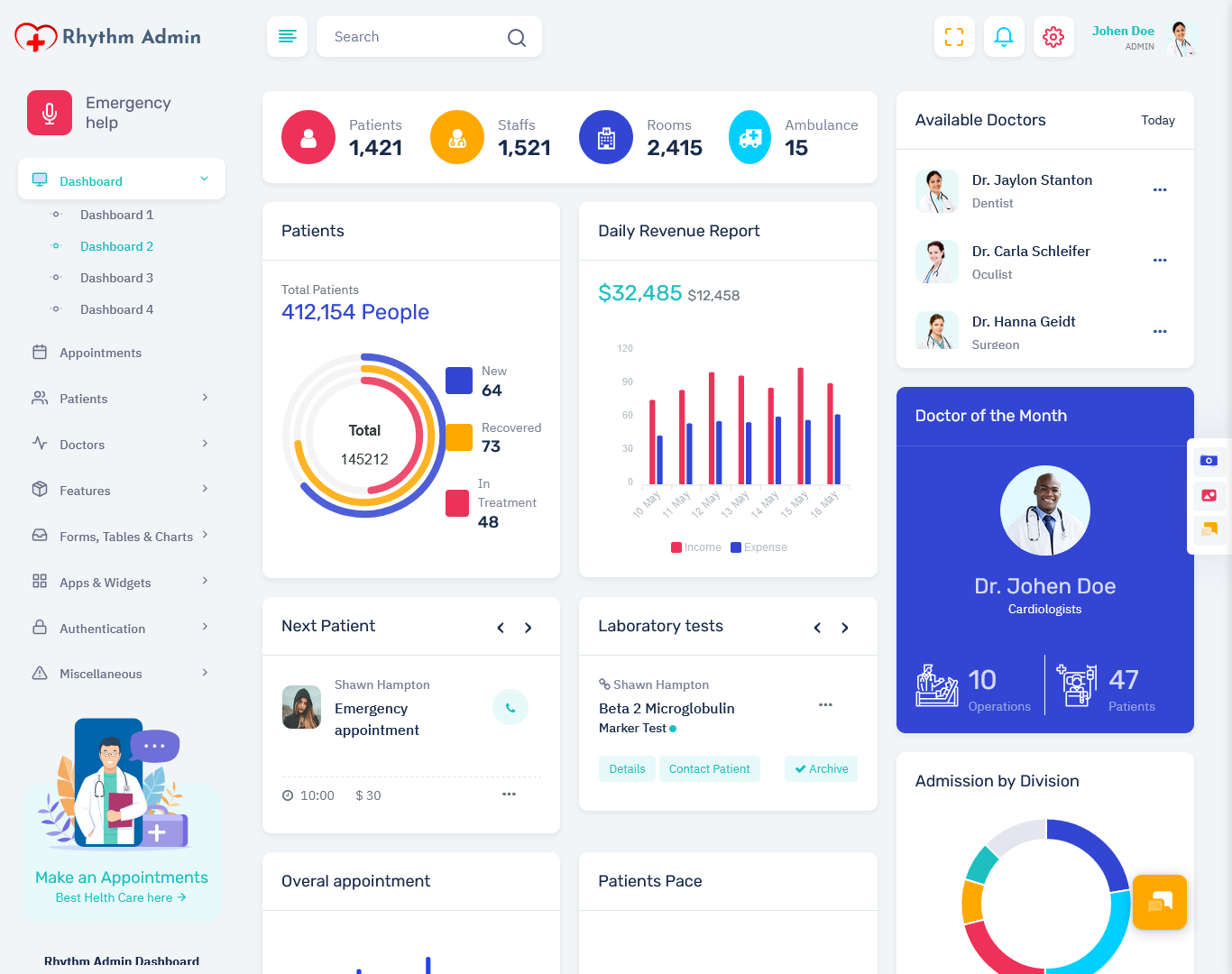
MORE INFO / BUY NOW DEMO
LTR Style Dashboard – 3
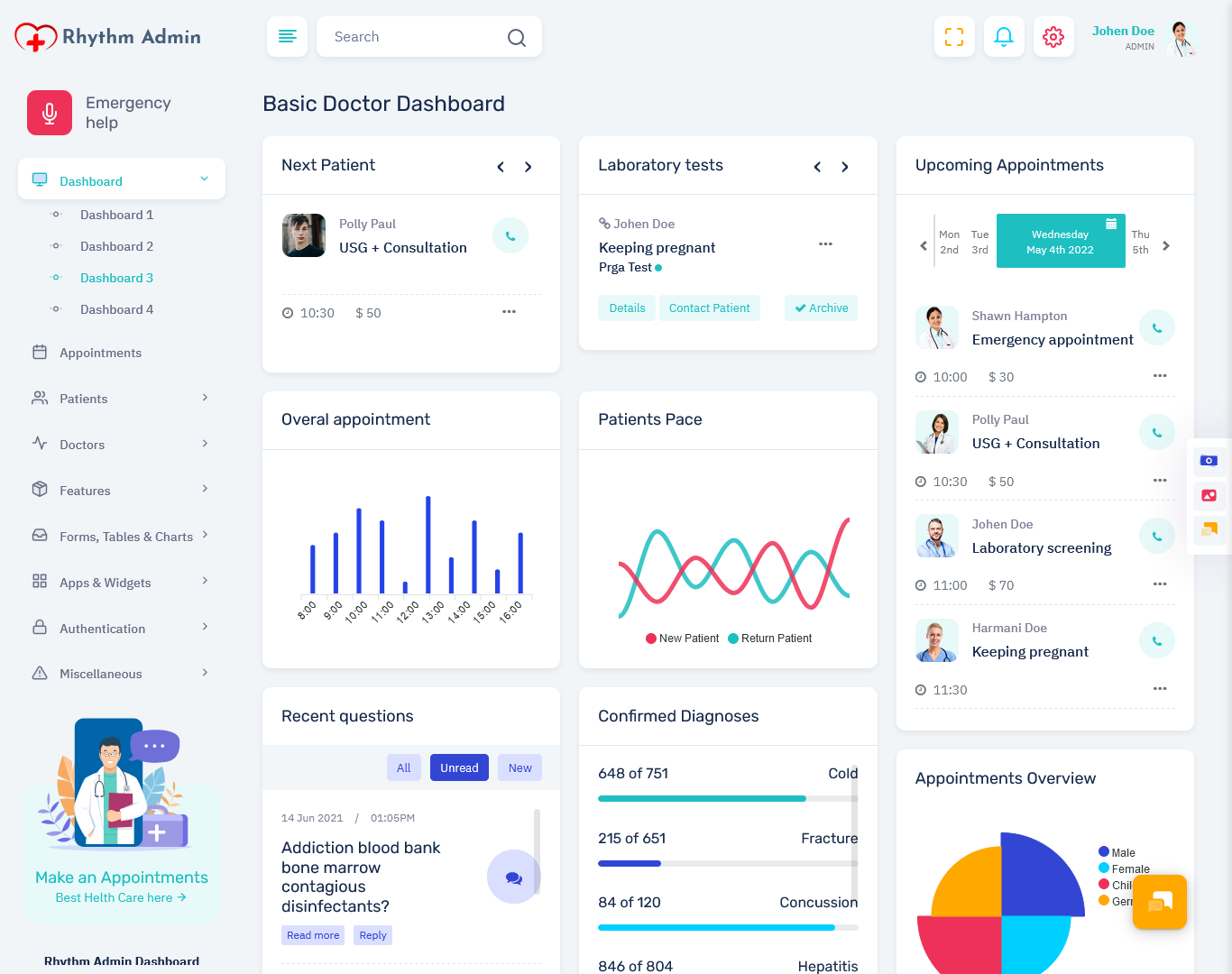
MORE INFO / BUY NOW DEMO
LTR Style Dashboard – 4
MORE INFO / BUY NOW DEMO
Videos of Rhythm Admin
3. Benefits of Using a Hospital Dashboard
The implementation of an advanced Medical Dashboard can significantly improve various aspects of hospital operations and patient care. Here are some key benefits:
a) Improved Patient Care
With real-time access to patient reports and data, doctors can make quicker, more informed decisions. Immediate access to medical history, diagnostic results, and medication records helps prevent delays in treatment and reduces the risk of errors. Moreover, the dashboard enables continuous monitoring of patient health, ensuring prompt responses in emergencies.
b) Increased Efficiency and Productivity
A hospital dashboard minimizes the need for manual data entry and paperwork by consolidating data in one centralized location. This saves time for hospital staff, allowing them to focus more on patient care rather than administrative tasks. Additionally, automation of tasks like appointment scheduling, medication tracking, and billing improves overall operational efficiency.
c) Enhanced Decision-Making
Hospital administrators and medical professionals can make data-driven decisions with the help of real-time analytics. With accurate data on staffing, patient volume, equipment usage, and treatment outcomes, administrators can plan and allocate resources more effectively, ensuring better patient outcomes.
d) Streamlined Communication and Collaboration
The dashboard fosters better communication among hospital departments by consolidating data and facilitating collaboration. Doctors, nurses, administrators, and other medical staff can access shared information, improving coordination of patient care and decision-making processes.
e) Financial Optimization
Real-time financial monitoring and reporting can help hospitals reduce waste, manage costs more effectively, and optimize revenue generation. The hospital dashboard’s financial analytics tools can track claims, patient billing, and reimbursement processes, improving overall financial health.
4. Conclusion
The Hospital Dashboard is not just a tool for tracking patient data but a comprehensive solution for improving hospital operations and patient outcomes. With its ability to provide real-time insights into patient health, doctor performance, hospital finances, and operational processes, the dashboard helps healthcare professionals make informed decisions quickly, ultimately leading to better care for patients.
As healthcare systems get more complicated, using advanced tools like hospital dashboards is becoming more important. A hospital dashboard helps manage many tasks easily, making sure that healthcare facilities can provide the best care for their patients. Whether you run a small clinic or a big hospital, adding a hospital dashboard can improve how the hospital operates, make patients happier, and help with managing finances better.
By Using these advanced features, hospitals can meet the evolving demands of modern healthcare, ensuring high-quality care in a timely and cost-effective manner.
As healthcare systems get more complicated, using advanced tools like hospital dashboards is becoming more important. A Medical Dashboard helps manage many tasks easily, making sure that healthcare facilities can provide the best care for their patients. Whether you run a small clinic or a big hospital, adding a hospital dashboard can improve how the hospital operates, make patients happier, and help with managing finances better.
 skip to Main Content
skip to Main Content


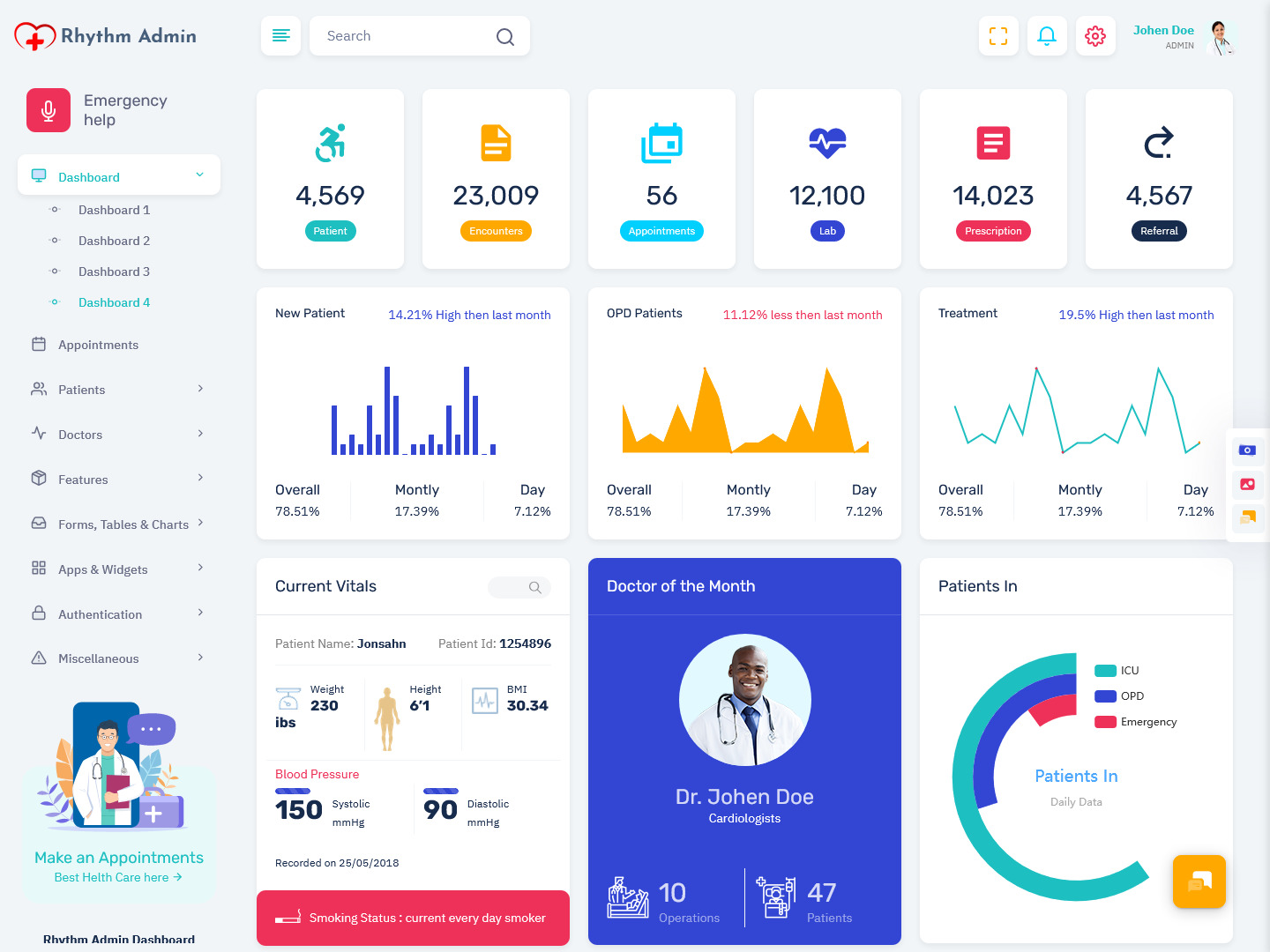

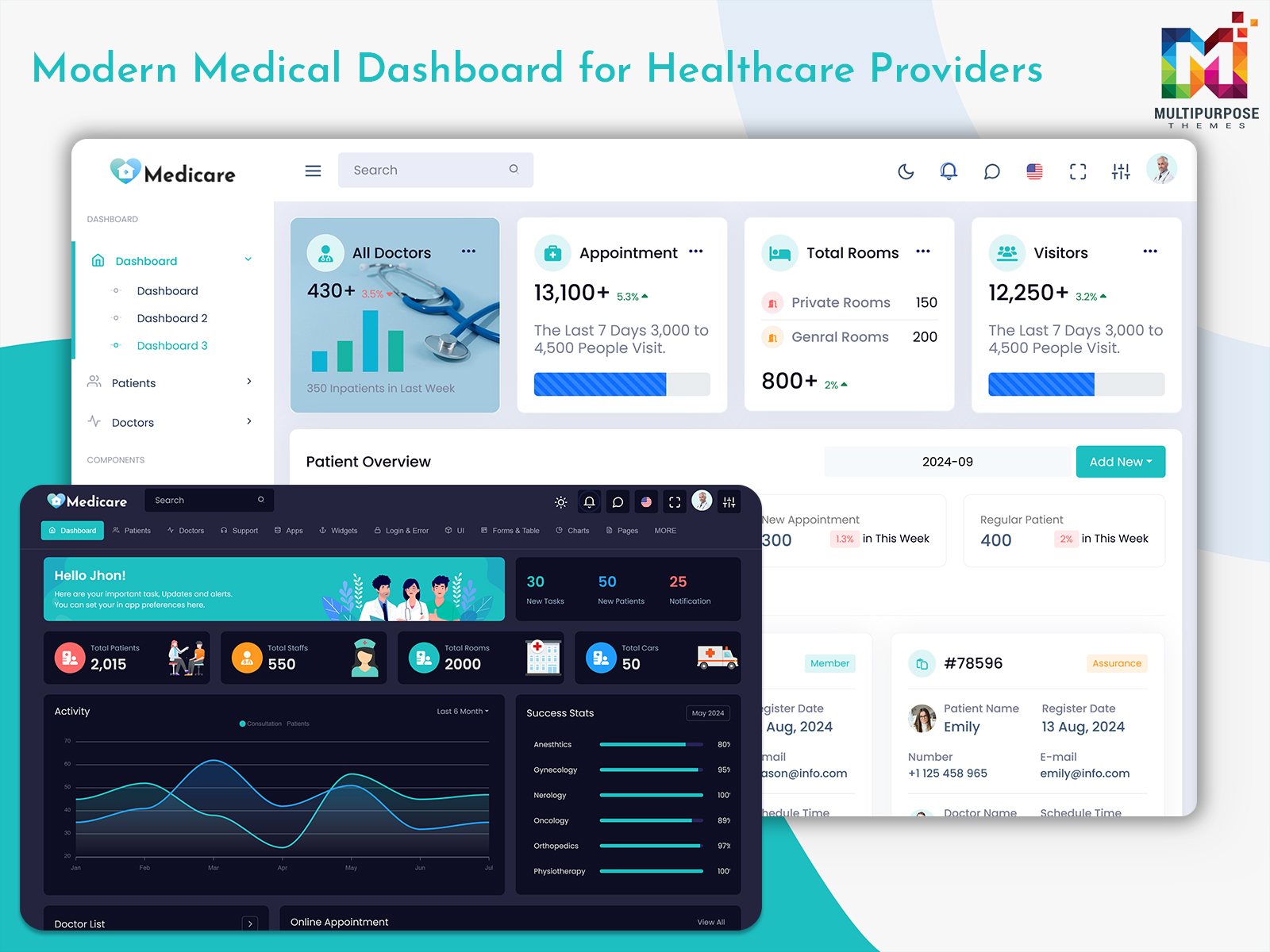

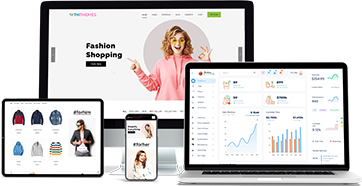

This Post Has 0 Comments